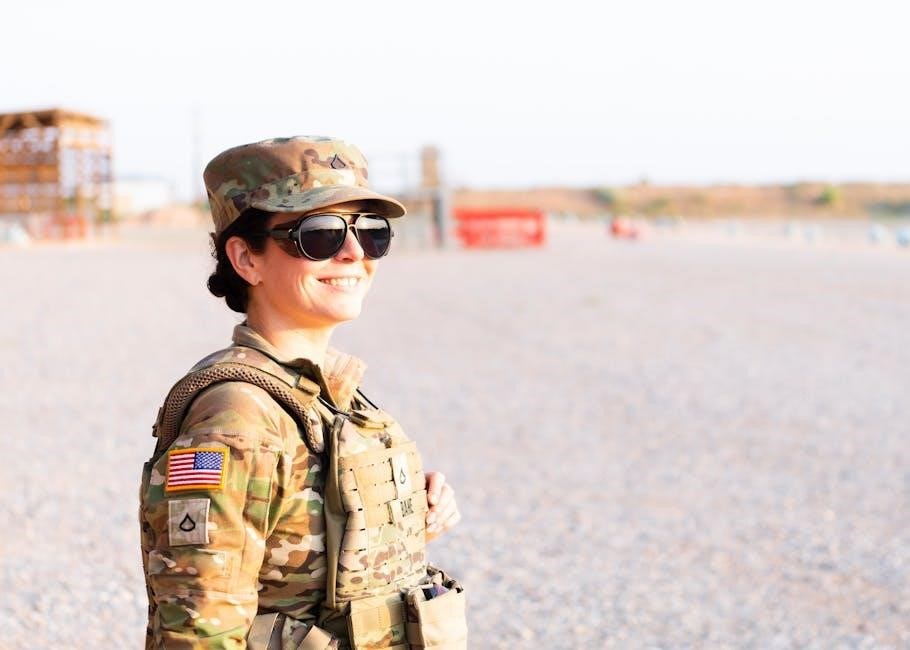Security Classification Guides are official documents outlining procedures for handling classified information. They ensure sensitive data is protected and accessed appropriately‚ with CPL Rice and SGT Davis playing key roles in maintaining these standards.
1.1 Definition and Purpose of Security Classification Guides
Security Classification Guides are official documents that outline procedures for handling sensitive information. Their purpose is to protect national security by ensuring classified data is accessed only by authorized personnel. These guides define classification levels‚ such as Confidential‚ Secret‚ and Top Secret‚ to prevent unauthorized disclosure. CPL Rice and SGT Davis‚ as security experts‚ play crucial roles in implementing these guidelines‚ ensuring compliance and maintaining the integrity of classified information systems.
1.2 Importance of Security Classification in Modern Organizations
Security classification is vital for modern organizations to safeguard sensitive information from unauthorized access. It ensures that data is categorized based on its sensitivity‚ preventing potential breaches. CPL Rice and SGT Davis emphasize the importance of classification in maintaining national security and organizational integrity. By adhering to these guidelines‚ organizations can protect their assets‚ comply with regulations‚ and uphold trust with stakeholders in an increasingly digital and vulnerable world.

Understanding the Roles of CPL Rice and SGT Davis
CPL Rice and SGT Davis are experts in security protocols‚ ensuring classified information is handled securely. Their roles involve training‚ enforcement‚ and maintaining strict adherence to classification standards.
2.1 CPL Rice: Overview of Responsibilities and Expertise
CPL Rice specializes in security classification‚ ensuring sensitive information is handled according to strict guidelines. His expertise includes training personnel‚ enforcing protocols‚ and managing access controls. Rice collaborates with SGT Davis to maintain the integrity of classified data‚ focusing on compliance and accountability. Together‚ they play pivotal roles in safeguarding national security through effective information management systems and adherence to established security standards.
2.2 SGT Davis: Key Contributions to Security Protocols
SGT Davis is instrumental in developing and implementing robust security protocols‚ ensuring classified information remains protected. His contributions include enhancing access control measures and conducting regular audits to maintain compliance. Collaborating closely with CPL Rice‚ Davis ensures all security practices align with federal standards‚ mitigating risks and upholding the highest levels of data integrity. His efforts are crucial in preventing breaches and ensuring the secure handling of sensitive materials.
2.3 Collaboration Between CPL Rice and SGT Davis
CPL Rice and SGT Davis collaborate seamlessly to ensure the integrity of security classification processes. Their joint efforts focus on maintaining stringent protocols‚ conducting regular audits‚ and training personnel. By combining Rice’s expertise in classification decisions with Davis’s strengths in access control‚ they create a comprehensive security framework. This partnership ensures all classified information is handled securely‚ adhering to federal guidelines and minimizing potential breaches.

Security Classification Process
The Security Classification Process involves systematic steps to protect sensitive information. CPL Rice and SGT Davis ensure proper categorization and secure handling per federal guidelines.
3.1 Steps Involved in Classifying Sensitive Information
Classifying sensitive information involves identifying‚ categorizing‚ and labeling data based on its sensitivity. CPL Rice and SGT Davis follow strict guidelines to ensure accuracy. They assess the potential impact of unauthorized disclosure‚ applying labels like Confidential‚ Secret‚ or Top Secret. Proper classification ensures only authorized personnel access the information‚ maintaining national security and organizational integrity. This process is crucial for safeguarding data and preventing breaches‚ with CPL Rice and SGT Davis leading the implementation of these protocols effectively.
3.2 Determining Classification Levels: Confidential‚ Secret‚ Top Secret
Classification levels are determined based on the potential harm to national security if the information is disclosed. Confidential information causes damage‚ Secret causes serious damage‚ and Top Secret causes exceptionally grave damage. CPL Rice and SGT Davis assess the sensitivity and impact‚ applying these labels accordingly. They ensure proper classification aligns with security protocols‚ preventing unauthorized access and maintaining data integrity. Their expertise guarantees that each level is assigned accurately‚ safeguarding critical information effectively.
3.3 Role of CPL Rice and SGT Davis in Classification Decisions
CPL Rice and SGT Davis play pivotal roles in classification decisions‚ ensuring sensitive information is appropriately labeled. Their expertise in security protocols allows them to assess the sensitivity and potential impact of data. CPL Rice focuses on evaluating the nature of information‚ while SGT Davis ensures proper classification labels are applied. Together‚ they maintain the integrity of security classifications‚ preventing unauthorized access and safeguarding national security. Their collaborative approach guarantees accurate and compliant decisions‚ upholding the highest security standards.

Handling and Storage of Classified Information
Classified information requires secure storage and safe handling. CPL Rice and SGT Davis ensure compliance with strict protocols to protect sensitive data from unauthorized access.
4.1 Secure Storage Solutions for Sensitive Data
Secure storage solutions are essential for protecting classified information. CPL Rice and SGT Davis utilize advanced encryption and secure communication channels to ensure sensitive data remains confidential. They employ biometric authentication and encrypted systems to prevent unauthorized access. Proper storage solutions prevent breaches and maintain the integrity of classified information.
4.2 Best Practices for Accessing Classified Materials
Accessing classified materials requires strict adherence to security protocols. CPL Rice and SGT Davis emphasize the importance of secure authentication and authorization. Personnel must verify their need-to-know status before accessing sensitive information. Minimizing access to essential personnel reduces breach risks. Documentation of access events ensures accountability. Adhering to these practices maintains the integrity of classified data and aligns with security classification guidelines.
4.3 Emergency Protocols for Breaches or Loss of Classified Information
In case of a breach or loss of classified information‚ immediate action is crucial. CPL Rice and SGT Davis oversee containment measures‚ ensuring minimal exposure. They coordinate with security teams to isolate affected areas and recover compromised materials. Prompt reporting to higher authorities is mandatory‚ followed by a thorough investigation. Post-incident‚ enhanced safeguards are implemented to prevent future occurrences‚ maintaining the integrity of security classification standards.

Security Clearance and Access Levels
Security clearance ensures authorized access to classified information‚ with levels based on the need-to-know principle. CPL Rice and SGT Davis manage clearances‚ ensuring compliance and proper access.
5.1 Overview of Security Clearance Process
The security clearance process involves background investigations and authorization to access classified information. CPL Rice and SGT Davis oversee this process‚ ensuring compliance with regulations. They verify personnel qualifications and adjudicate clearance levels based on the need-to-know principle‚ safeguarding sensitive data. Proper clearance ensures only authorized individuals handle classified materials‚ maintaining national security and organizational integrity. This systematic approach prevents unauthorized access and potential breaches‚ aligning with modern security protocols and guidelines.
5.2 Need-to-Know Principle in Access Control
The need-to-know principle restricts access to classified information only to those essential for mission execution. CPL Rice and SGT Davis enforce this by assessing personnel’s access requirements‚ ensuring no unnecessary exposure. This principle minimizes leaks by limiting distribution‚ aligning with modern security protocols. It safeguards sensitive data‚ preventing breaches and maintaining confidentiality‚ while allowing authorized personnel to perform duties effectively.
5.3 CPL Rice and SGT Davis: Ensuring Proper Clearance Adherence
CPL Rice and SGT Davis are instrumental in verifying that all personnel adhere to security clearance protocols. They conduct regular audits and training sessions to ensure compliance. Their oversight guarantees that classified information is only accessible to authorized individuals. By maintaining strict adherence to clearance guidelines‚ they protect sensitive data from unauthorized access‚ upholding the integrity of security classification standards within the organization.

Declassification and Information Sharing
Declassification involves removing sensitive information’s classified status‚ allowing controlled sharing. CPL Rice and SGT Davis ensure this process follows strict protocols to maintain confidentiality and compliance.
6.1 Criteria for Declassifying Information
Declassification criteria ensure information is no longer sensitive. CPL Rice and SGT Davis verify eligibility‚ ensuring only authorized personnel access declassified data‚ maintaining security integrity.
6.2 Procedures for Sharing Classified Information with External Agencies
Sharing classified information with external agencies requires strict adherence to security protocols. CPL Rice and SGT Davis ensure proper clearance verification of recipients. Information is shared only on a need-to-know basis‚ with non-disclosure agreements in place to maintain confidentiality. All transfers are documented‚ and access is monitored to prevent unauthorized disclosure. This ensures compliance with security guidelines while fostering necessary collaboration.
6.3 Role of CPL Rice and SGT Davis in Declassification Processes
CPL Rice and SGT Davis play pivotal roles in declassification processes by reviewing classified information for potential public release. They ensure compliance with declassification guidelines‚ verifying that sensitive data no longer requires protection. Rice leads the evaluation of documents‚ while Davis handles secure documentation and clearance verification. Together‚ they maintain accountability and ensure transparency‚ balancing national security with public interest in declassified materials.

Training and Awareness for Security Protocols
Training and awareness programs are essential for ensuring personnel understand security protocols. Mandatory programs‚ led by CPL Rice and SGT Davis‚ emphasize continuous education to maintain compliance and vigilance.
7.1 Mandatory Training Programs for Personnel
Mandatory training programs ensure all personnel understand security protocols and classification procedures. These programs‚ often led by CPL Rice and SGT Davis‚ cover essential topics such as handling classified information‚ access controls‚ and emergency protocols. Regular updates and refresher courses are implemented to maintain compliance and address evolving threats. Training emphasizes the importance of adherence to security guidelines‚ ensuring personnel are equipped to protect sensitive data effectively. Continuous education is a cornerstone of maintaining robust security practices within the organization.
7.2 CPL Rice and SGT Davis: Leading Training Initiatives
CPL Rice and SGT Davis are instrumental in leading comprehensive training programs‚ ensuring personnel are well-versed in security protocols. They develop curriculum‚ conduct interactive sessions‚ and provide hands-on exercises to reinforce classification procedures. Their expertise ensures training aligns with current security standards‚ addressing real-world scenarios and emerging threats. By fostering a culture of accountability‚ they equip personnel with the knowledge and skills needed to maintain robust security practices‚ ensuring compliance and protecting sensitive information effectively.
7.3 Importance of Continuous Education in Security Protocols
Continuous education is vital to staying updated on evolving security protocols and threats. Regular training ensures personnel understand the latest classification standards‚ maintaining compliance and mitigating risks. CPL Rice and SGT Davis emphasize the need for ongoing learning‚ fostering a culture of accountability and adaptability. This approach ensures that security practices remain robust‚ aligning with modern challenges and safeguarding sensitive information effectively. Education reinforces the foundational principles of security classification‚ ensuring long-term protection of critical data.

Violations and Consequences
Security violations can lead to severe legal and operational repercussions. CPL Rice and SGT Davis enforce strict accountability‚ ensuring compliance and mitigating risks of data breaches and penalties.
8.1 Types of Security Violations and Their Implications
Security violations include unauthorized access‚ improper handling‚ or mishandling of classified information. These breaches can lead to legal penalties‚ loss of clearance‚ and compromised national security. CPL Rice and SGT Davis ensure strict adherence to protocols‚ addressing violations through thorough investigations and corrective actions. Their oversight helps mitigate risks and maintain the integrity of security systems. Violations are categorized based on severity‚ with consequences ranging from disciplinary actions to criminal charges. Proper training and accountability are key to preventing such incidents.
8.2 Investigating and Addressing Breaches of Security Protocols
Investigating breaches involves thorough forensic analysis and interviews to identify root causes. CPL Rice and SGT Davis oversee corrective actions‚ ensuring accountability and preventing future incidents. Breaches are addressed through disciplinary measures‚ enhanced training‚ and improved protocols. Their collaborative efforts ensure security standards are upheld‚ minimizing risks and safeguarding sensitive information. Prompt action is crucial to mitigate damage and maintain trust in security systems.
8.3 CPL Rice and SGT Davis: Ensuring Accountability and Compliance
CPL Rice and SGT Davis play pivotal roles in maintaining accountability by rigorously enforcing security protocols. They conduct regular audits and inspections to ensure compliance with classification standards. Violations are addressed promptly‚ with corrective actions implemented to prevent future breaches. Their leadership fosters a culture of compliance‚ ensuring all personnel adhere to security guidelines. Through continuous oversight and training‚ they uphold the integrity of classified information systems‚ safeguarding sensitive data effectively.

Advanced Security Measures and Technologies
Advanced security includes multi-factor authentication and real-time threat detection. CPL Rice and SGT Davis implement cutting-edge technologies to safeguard classified information‚ ensuring robust protection against evolving threats.
9.1 Use of Encryption and Secure Communication Channels
Encryption is a cornerstone of modern security‚ protecting data at rest and in transit. CPL Rice and SGT Davis emphasize the use of advanced encryption protocols and secure communication channels‚ such as VPNs and TLS‚ to safeguard classified information. These technologies ensure confidentiality‚ integrity‚ and authenticity‚ preventing unauthorized access. Secure communication channels are essential for sharing sensitive data‚ and their proper implementation is a key responsibility of CPL Rice and SGT Davis in maintaining robust security standards.
9.2 Role of Biometric Authentication in Security Systems
Biometric authentication enhances security by verifying individuals through unique physical traits like fingerprints or facial recognition. CPL Rice and SGT Davis advocate for its use to prevent unauthorized access to classified information. Biometric systems provide an additional layer of security‚ ensuring only authorized personnel can handle sensitive data. This method complements encryption and secure communication channels‚ offering robust protection against breaches and maintaining the integrity of security protocols.
9.3 CPL Rice and SGT Davis: Implementing Cutting-Edge Security Solutions
CPL Rice and SGT Davis are instrumental in integrating advanced security technologies‚ such as biometric authentication and encryption‚ to safeguard classified information. Their expertise ensures seamless implementation of these solutions‚ enhancing organizational security. By staying ahead of emerging threats‚ they adapt security protocols to meet modern challenges‚ ensuring compliance and protecting sensitive data effectively.
Real-World Applications and Case Studies
CPL Rice and SGT Davis demonstrate practical applications of security classification guides in real-world scenarios‚ ensuring classified information is handled securely and efficiently across various operations.
10.1 Historical Examples of Effective Security Classification
Historical cases‚ such as the Manhattan Project‚ highlight successful security classification. CPL Rice and SGT Davis study these examples to refine modern protocols‚ ensuring sensitive data remains protected while fostering collaboration. Their expertise draws from past successes to implement robust security measures‚ balancing confidentiality with operational needs. These historical lessons underscore the importance of stringent classification guides in safeguarding national security and preventing unauthorized disclosures.
10.2 Lessons Learned from Past Security Breaches
Past security breaches reveal critical gaps in classification protocols. CPL Rice and SGT Davis analyze these incidents to strengthen access controls and encryption. Historical breaches highlight the importance of strict adherence to classification guides‚ emphasizing the need for continuous training and accountability. These lessons shape modern security practices‚ ensuring classified information remains protected and breaches are mitigated effectively. Their expertise ensures protocols evolve‚ addressing vulnerabilities and enhancing overall security frameworks.
10.3 CPL Rice and SGT Davis: Case Studies in Modern Security Practices
CPL Rice and SGT Davis exemplify modern security practices through real-world applications. They applied classification guides to mitigate breaches‚ ensuring sensitive data remained secure. Their expertise in encryption and secure storage solutions resolved critical vulnerabilities. Case studies highlight their role in adapting protocols to emerging threats‚ demonstrating effective problem-solving and adherence to security guidelines. Their contributions underscore the importance of robust classification systems in safeguarding information and maintaining organizational integrity in the digital age.
Future Trends in Security Classification
Future trends in security classification emphasize advanced encryption‚ biometric authentication‚ and AI-driven threat detection. CPL Rice and SGT Davis lead initiatives to integrate these technologies‚ ensuring robust protection of sensitive information.

11.1 Emerging Threats and Challenges in Security Classification
Emerging threats include cyberattacks‚ insider threats‚ and data breaches. CPL Rice and SGT Davis address these challenges by implementing advanced encryption and biometric authentication‚ ensuring classified information remains secure. They stay ahead of evolving threats‚ adapting protocols to safeguard sensitive data in an increasingly digital world.
11.2 Evolution of Security Protocols in the Digital Age
Security protocols have evolved significantly with advancements in technology. CPL Rice and SGT Davis emphasize the adoption of encryption‚ secure communication channels‚ and biometric authentication to protect classified information. These measures address modern threats and ensure data integrity. The shift toward digital platforms requires robust access controls and regular updates to classification guidelines‚ ensuring compliance with emerging standards and safeguarding sensitive information in a rapidly changing environment.
11.3 CPL Rice and SGT Davis: Adapting to Future Security Needs
CPL Rice and SGT Davis are pivotal in adapting security protocols to future challenges. They advocate for proactive measures‚ such as integrating advanced encryption and AI-driven threat detection‚ to safeguard classified information. By staying ahead of emerging threats‚ they ensure robust security frameworks. Their collaborative approach fosters innovation‚ enabling organizations to maintain compliance and protect sensitive data in an ever-evolving digital landscape.
The security classification guide underscores the vital contributions of CPL Rice and SGT Davis in safeguarding sensitive information. Their expertise ensures the effectiveness of security protocols.
12.1 Summary of Key Points
The security classification guide provides a structured framework for managing sensitive information‚ ensuring confidentiality‚ integrity‚ and availability. CPL Rice and SGT Davis play pivotal roles in enforcing these protocols‚ from classification to declassification. Their expertise is crucial in maintaining security clearance standards‚ preventing breaches‚ and adapting to evolving threats. The guide emphasizes the need-to-know principle‚ proper handling of classified materials‚ and continuous training to uphold security integrity. Their collaborative efforts ensure robust protection of national security assets in a dynamic environment.
12.2 The Impact of CPL Rice and SGT Davis on Security Classification
CPL Rice and SGT Davis have significantly enhanced security classification processes through their expertise and collaborative efforts. CPL Rice ensures accurate classification of sensitive information‚ while SGT Davis leads training initiatives‚ fostering a culture of compliance. Their combined efforts have strengthened security protocols‚ preventing breaches and ensuring adherence to clearance standards. Their contributions have been instrumental in adapting classification guidelines to modern threats‚ safeguarding national security and maintaining the integrity of classified information.
12;3 Final Thoughts on the Importance of Security Classification Guides
Security Classification Guides are indispensable for safeguarding sensitive information and ensuring compliance with security protocols. CPL Rice and SGT Davis have been pivotal in their development and implementation‚ ensuring that classified data remains protected. Their efforts have significantly reduced the risk of breaches and enhanced the overall security framework. As security threats evolve‚ these guides‚ supported by experts like CPL Rice and SGT Davis‚ remain essential for maintaining national security and organizational integrity.










